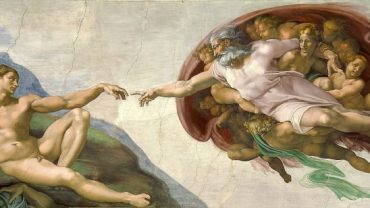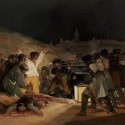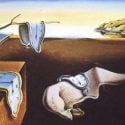Renaissance Art Symbolism and Hidden Meanings
During the Renaissance, art became more than a reflection of the visible world—it became a coded language of belief and philosophy.
Renaissance art symbolism reveals how artists embedded layers of meaning in their works—transforming color, light, and gesture into spiritual language. Every petal, animal, or gesture held a purpose, inviting viewers to look beyond the visible and toward the divine.
In an age when books were scarce and most people were illiterate, paintings served as visual theology and moral storytelling. Understanding this symbolic vocabulary allows us to step inside the Renaissance mind—to witness how art once spoke where words could not.
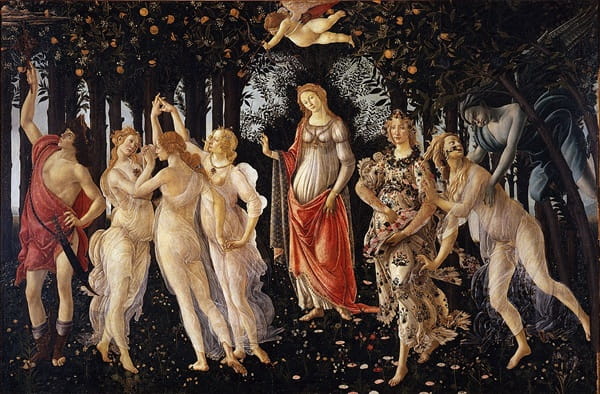
Primavera, late 1470s or early 1480s by Sandro Botticelli – Uffizi, Florence – Renaissance Art Symbolism.
When Art Spoke in Codes
1- A World Reborn: The Symbolic Foundation of Renaissance Thought
The Renaissance was an age of rebirth—of art, science, and spiritual meaning. Artists reinterpreted Christian narratives through the lens of humanism, blending ancient mythology with sacred imagery.
Symbols became the visual vocabulary of the time:
-
Lilies represented purity and were closely linked to the Virgin Mary.
-
Books symbolized divine knowledge and the Word of God.
-
Skulls reminded viewers of mortality (memento mori).
-
Dogs embodied loyalty and marital fidelity.
These details transformed paintings into theological messages accessible even to the illiterate. Through symbols, art became philosophy made visible.
–

The Arnolfini Portrait, 1434 by Jan van Eyck – National Gallery, London – The Hidden Language of Symbols in Renaissance Art.
Recommended For You – Jan van Eyck and The Details Of The Arnolfini Portrait
2- Leonardo da Vinci: Science, Spirit, and Symbol
Leonardo da Vinci approached painting as a union of art and science. He believed that nature itself was filled with divine symbolism, waiting to be discovered.
In The Last Supper, his visual storytelling replaces words:
-
Christ’s triangular form represents divine perfection and harmony.
-
Judas’s hand clutching a money bag signals betrayal and greed.
-
A spilled salt cellar—a subtle but powerful symbol—suggests the loss of divine grace.
In The Virgin of the Rocks, Leonardo used light and shadow to create a visual hierarchy between the human and the divine. His symbolism in Renaissance paintings was grounded not in mysticism but in geometry and proportion—truth revealed through balance.

The Last Supper, 1495-1498 by Leonardo da Vinci – Renaissance Art Symbolism.
Recommended For You – 8 Things You Need To Know About Da Vinci‘s The Last Supper
3- Michelangelo: The Human Body as a Sacred Code
Michelangelo viewed the human body as the purest reflection of God’s image. His art celebrated human form as both physical perfection and spiritual metaphor.
In The Creation of Adam, the moment between the divine and the human is rendered through a single gesture—the touch of life.
The shape of God’s cloud, resembling a human brain, has led scholars to interpret it as a symbol of divine intellect.
In The Last Judgment, muscular bodies symbolize the struggle between salvation and damnation.
Michelangelo’s work embodies religious symbols in Renaissance art, demonstrating that anatomy and theology could coexist on a single fresco.
–

The Creation of Adam, 1511 by Michelangelo – Sistine Chapel, Vatican City – The Hidden Language of Symbols in Renaissance Art.
4- Botticelli and the Language of Myth
Sandro Botticelli blended Christian spirituality with pagan mythology to express universal ideals. His paintings serve as allegories of moral and philosophical concepts.
In The Birth of Venus, Venus’s emergence from the sea symbolizes divine beauty and the rebirth of love—an echo of the soul’s awakening.
In Primavera, Mercury, Flora, and Zephyr personify spiritual renewal, reason, and desire in harmonious balance.
Botticelli’s Renaissance art symbolism bridges heaven and earth—turning myth into moral reflection and beauty into metaphysical truth.

The Birth of Venus, 1484-1486 by Sandro Botticelli – Uffizi Gallery, Florence – Renaissance Art Symbolism.
5- Nature’s Language: Reading the Divine in the Everyday
Nature in Renaissance art was never a backdrop—it was a mirror of the divine.
Plants, fruits, and animals carried layers of moral and spiritual significance:
-
Apples symbolized temptation and original sin.
-
Grapes represented sacrifice and redemption.
-
Peacocks signified immortality.
-
Rabbits reflected fertility and rebirth.
Northern Renaissance artists, like Hugo van der Goes and Jan van Eyck, depicted nature with botanical precision, turning flora into coded theology. Each detail invited contemplation of life, death, and eternity.
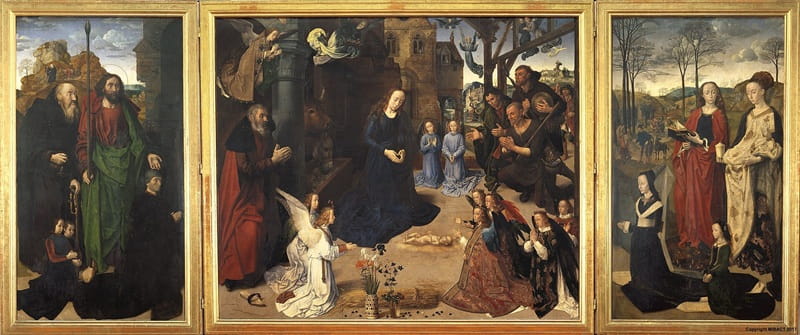
Portinari Altarpiece, 1475–1476 by Hugo van der Goes – Uffizi Gallery, Florence – The Hidden Language of Symbols in Renaissance Art.
6- Decoding the Canvas: Why Renaissance Symbolism Still Matters
Modern audiences often overlook these symbolic layers, seeing paintings only as decoration. But the Renaissance artist saw painting as a sacred dialogue between reason and faith.
To read this symbolism is to rediscover the Renaissance worldview—a harmony of knowledge, beauty, and divine purpose.
Today, museums invite viewers not just to look, but to decode—to slow down and engage in the same silent conversation that inspired artists 500 years ago.
Recommended For You – The 10 Best Art Museums in the World

Primavera, late 1470s or early 1480s by Sandro Botticelli – Uffizi, Florence.
The Eternal Language of Beauty
The symbols of Renaissance art continue to speak, centuries later. They remind us that beauty was once a form of wisdom—where color and light carried divine meaning.
To understand Renaissance art symbolism is to see not just paintings, but the philosophy of an age that believed in the sacred connection between truth and art.
References:
- https://en.wikipedia.org/wiki/Primavera_(Botticelli)
- https://en.wikipedia.org/wiki/Arnolfini_Portrait
- https://en.wikipedia.org/wiki/Portinari_Altarpiece





